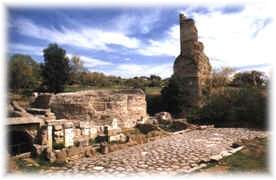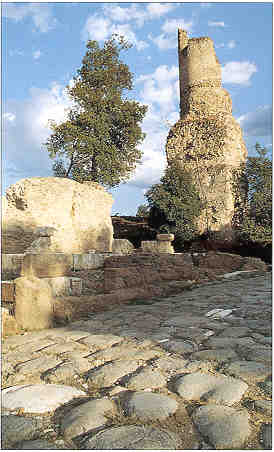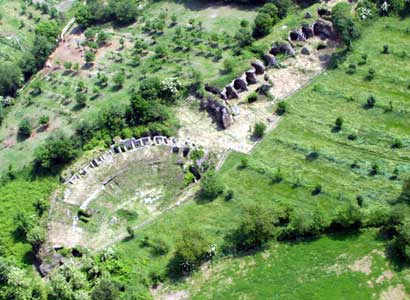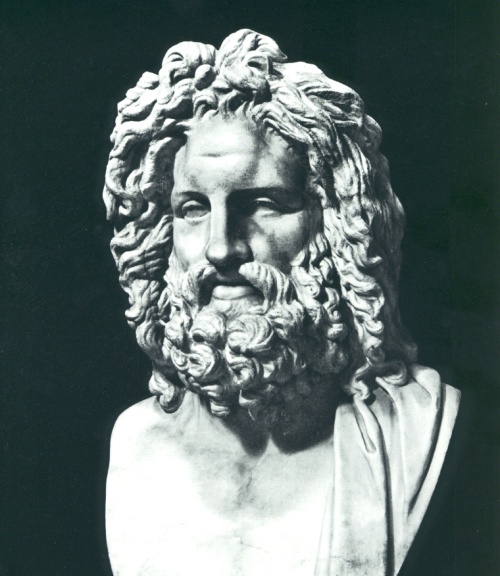|
Le Corone
UMBRIA - 05030 OTRICOLI - TR - ITALY - Via Valle Figliola snc
e-mail: lecorone@fastwebnet.it - info@lecorone.it
Tel: +39 (0)68075028 Fax: +39 (0)68077372 Mob:+39 3394499075
Ocricolum and the Archaeological Itinerary
The antique umbrian centre of Ocricolum rose on the hill where is the modern Otricoli. There are ruins of walls witnessing the existence of this centre on the hill during the preroman period.
People went down to the banks of the Tiber in the second century b.C. in order to use better that very important commercial way which would be basic for the birth of the huge roman city called Ocricolum. In this area there are remarkable ruins of public buildings known since the renaissance when the pontifical exavations brought to light a lot of works of art and inscriptions (among wich the famous Jove and the Mosaic of Thermae) that nowadays are kept for the most part in the Vatican museums.
The surviving and the visible remnants are impressive in the archeological zone. Almost all monuments belong to the same era, probably the Augustan age; those are theatre and anphitheatre very well kept, plus a huge arched sustraction carryng one of the most important monument of the city, maybe the Capitolium. The thermae, on the contrary, belong to the second century, once decorated by figured mosaics, built on an artificial plan and made possible by the immission of Saint Vittore brook into an underground passage.
People returned to the hill perhaps during the second half of the 6th century to get away from the insane climate of that area due to continuous moving of bed of the Tiber or in order to defend themselves from
the barbaric invasions.
A Church was built on the hill during the 7th century: Collegiate of S.Maria Assunta with walls in opus mixtum and reticulatum (roman materials). Nowadays all Otricolan Saint's relics are kept in the Collegiate Church.
Near Otricoli rises a little medieval castle: Poggio. It is immersed in Woods and it has the Church of Saint Nicola (1400), Castle of Arverino (1100) and the Church of Saint Vittore (1330).
This itinerary crosses the region longitudinally, through town centres, where the unification action conducted by the Roman colonisation has left deep tracks that are visible also in the road infrastructure.
Journeys relating to: Otricoli, Narni, Terni, Spoleto, Trevi, Carsulae, Bevagna, Foligno, Nocera Umbra, Gualdo Tadino, Fossato di Vico, Scheggia
Museums
Bevagna: Archaeological Museum
Foligno:Archaeological Collection
Fossato di Vico: Archaeological Collection
Gualdo Tadino: Archaeological Collection
Narni: Palaeontological Collection and Pre-historical Municipal Collection
Nocera: Archaeological Collection
Otricoli: Municipal Archaeological Collection
Sigillo:Municipal Collection
Spoleto: Archaeological Museum
Terni: Archaeological Museum
Trevi: Saint Francis Museum-Picture Gallery
This itinerary consists in longitudinally cutting through Umbria by following the road system that is part of Via Flaminia.
In the past it represented the centre of Roman excellence in Umbria, and was also used in later times by travellers and pilgrims heading to Rome from the northeast.
This road was made by the consul and censor Caio Flaminio, with the exploitation of other existing routes around the year 220 b.C. It was made for strategic-military purposes, and to satisfy the demand for a quick connecting route considering the Roman conquest of the Valle Padana. This artery is a clear testimony of the capillary and progressive occupation operations by Rome on the Italic territory, and of grading process and cultural layout that they achieved.
The course of the Flaminia, that entered Umbrian territory at Ocriculum, divides, near to the Latin colony of Narnia (Narni), into two well-distinguished branches with respect to the axes of the Martani Mountains. The western route headed towards Carsulae, Statio ad Martis (Massa Martana) and Mevania (Bevagna) and is generally indicated as the older of the two, while the eastern "diverticulum" headed towards Interamna Nahars (Terni) and Spoletium (Spoleto) and was considered to be successive.
In reality, it is highly probable that the two were made simultaneously, but answered different needs. It is in fact likely that the tract for Mevania could have been used for military displacement while the route for Spoletium was used for routine communications. The route becomes unique once more near to San Giovanni Profiamma, identified with the Roman site of Forum Flaminii and then continues towards Nuceria Camellaria (Nocera), Tadinum (Gualdo Tadino), vicus Helvillum (Fossato di Vico), exiting from the actual northern limits of the region at the Scheggia Pass (statio ad Hensem).
Along the route there is the possibility to visit many places of extraordinary interest, both cultural and beautiful landscapes, most of all touching ancient towns with historical continuity, among which the two Latin colonies of Narnia (Narni) and Spoletium (Spoleto), but also substantial archaeological events relative to urban entities that were abandoned in the late-ancient epoch - Ocriculum, with Umbrian and Roman appearance, and Carsulae -, which present such well detailed and defined realities, that they give us suggestive spaces, in which the ancient can be perfectly appreciated and understood.
There is a lot of material evidence relating to the road itself, both in the double southern route and in the "grande via", which can still be discovered and visited today. The section of Flaminia that once led from the Forum Flaminii to Rimini was known as the "grande via". Bridges of significant importance are present throughout this section, which according to ancient sources, were restored by Augusto after the Senate assigned him with Imperial power in 27 b.C.
The proposed itinerary consists in travelling across the entire Umbrian course of the Flaminia starting from either north (Scheggia) or south (Otricoli).
In both cases the tour uses one of the two diverticulum, leaving the other one for the return journey. Two alternative circuits that require less visiting time are also available. This option uses an ancient transverse connecting road of two Flaminia branches: via Romana or "delle Pecore".
I Circuit
The first circuit starts from Otricoli to Narni, and after visiting the city, returns back up along the eastern route to Terni, and later Spoleto. The Flaminia is left at this point and by travelling across via Romana you reach Carsualae. From this site, return to Narni by following the western diverticulum toward the south.
II Circuit
The second circuit leads to Foligno from Scheggia, and from Foligno, following the eastern branch of the Flaminia, goes on towards Trevi and to Spoleto. From this city, along the Via Romana, passing through the Macerino gorge
and Portaria, continue on to Carsulae and from here follow the southern diverticulum in a northern direction towards Bevagna and Foligno.
PICTURES |









